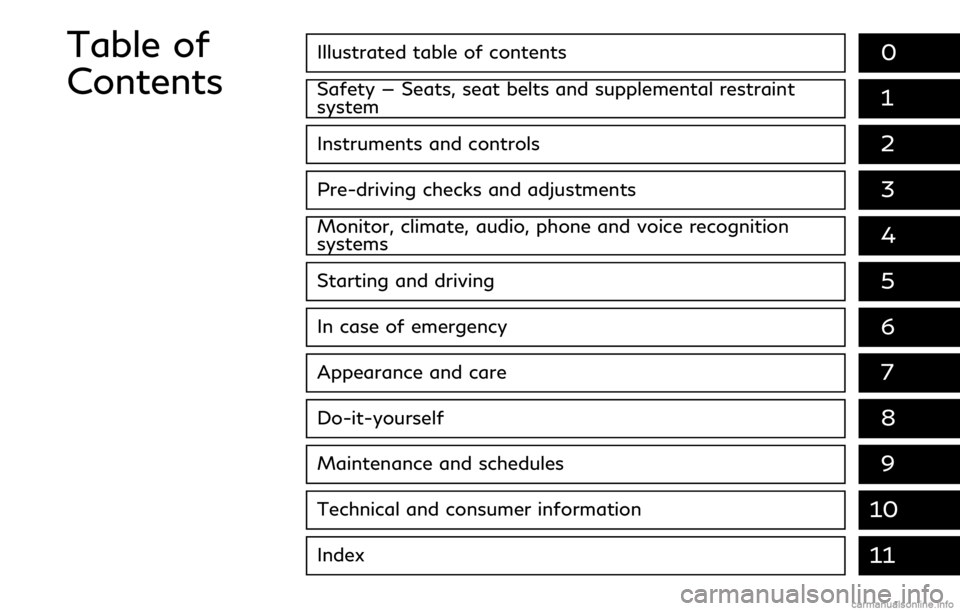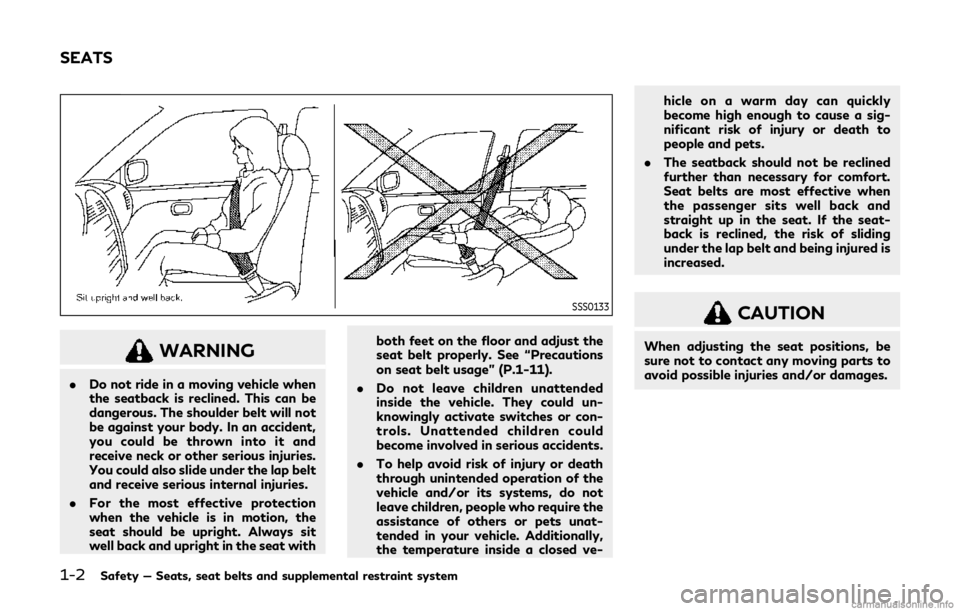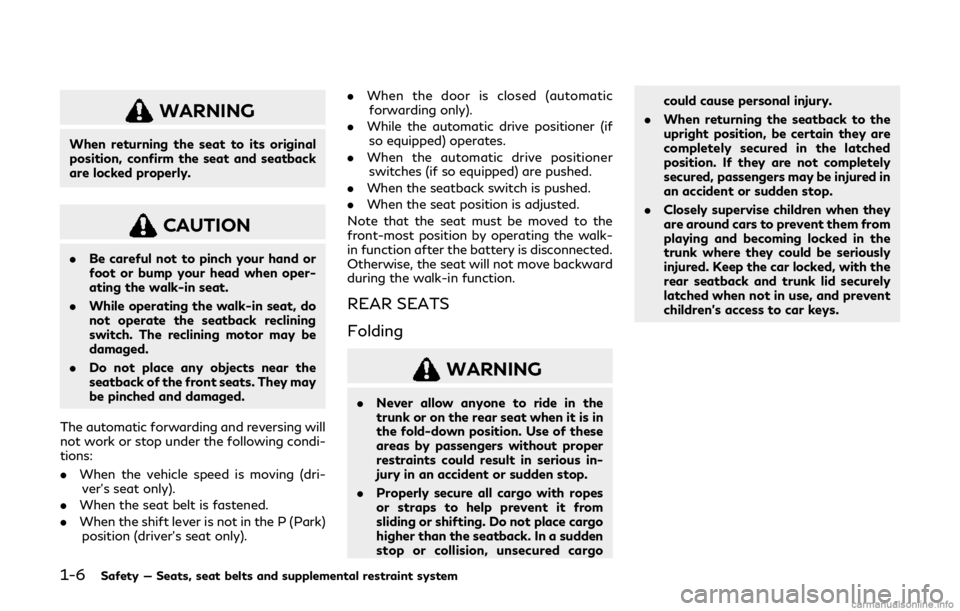seats INFINITI Q60 COUPE 2019 Owner's Manual
[x] Cancel search | Manufacturer: INFINITI, Model Year: 2019, Model line: Q60 COUPE, Model: INFINITI Q60 COUPE 2019Pages: 468, PDF Size: 2.19 MB
Page 7 of 468

Illustrated table of contents0
Safety — Seats, seat belts and supplemental restraint
system1
Instruments and controls
Pre-driving checks and adjustments
Monitor, climate, audio, phone and voice recognition
systems
Starting and driving
In case of emergency
Appearance and care
Do-it-yourself
Maintenance and schedules
Technical and consumer information
2
3
4
5
6
7
8
9
10
Table of
Contents
11Index
Page 9 of 468

0 Illustrated table of contents
Seats, seat belts and Supplemental Restraint
System (SRS) ...................................................................... 0-2
Exterior front ..................................................................... 0-3
Exterior rear ....................................................................... 0-4
Passenger compartment ................................................. 0-5
Cockpit ........................................................................\
......... 0-6Instrument panel .............................................................. 0-8
Meters and gauges .......................................................... 0-9
Engine compartment .................................................... 0-10
VR30DDTT engine ................................................ 0-10
2.0L turbo gasoline engine .................................. 0-11
Warning and indicator lights ...................................... 0-12
Page 10 of 468

0-2Illustrated table of contents
JVC0918X
1. Supplemental front-impact air bags(P.1-38)
2. Front seat-mounted side-impact sup- plemental air bags (P.1-38)
3. Seat belts (P.1-11)
4. Head restraints (P.1-7) 5. Roof-mounted curtain side-impact and
rollover supplemental air bags (P.1-38)
6. Child restraint anchor points (for top tether strap child restraint) (P.1-23,
P.1-30, P.1-34)
7. Occupant classification sensors (weight sensors) (P.1-44) 8. Front seats (P.1-3)
9. Seat belts with pretensioners (P.1-54)
10. Rear seat walk-in mechanism (P.1-5)
11. Rear seats (P.1-6)
— Child restraints (P.1-19)
12. LATCH (Lower Anchors and Tethers for CHildren) system (P.1-21)
SEATS, SEAT BELTS AND
SUPPLEMENTAL RESTRAINT
SYSTEM (SRS)
Page 21 of 468

1 Safety — Seats, seat belts and supplementalrestraint system
Seats ........................................................................\
.............. 1-2
Front seats ..................................................................... 1-3
Rear seats ....................................................................... 1-6
Head restraints/headrests .............................................. 1-7 Adjustable head
restraint/headrest components .............................. 1-8
Non-adjustable head
restraint/headrest components ............................... 1-9
Remove ........................................................................\
... 1-9
Install ........................................................................\
....... 1-9
Adjust ........................................................................\
... 1-10
Seat belts ........................................................................\
... 1-11 Precautions on seat belt usage .............................. 1-11
Pregnant women ....................................................... 1-13
Injured persons ........................................................... 1-13
Pre-crash seat belts with comfort function
(front seats) (if so equipped) .................................. 1-13
Three-point type seat belt ...................................... 1-14
Seat belt extenders ................................................... 1-16
Seat belt maintenance ............................................. 1-17
Child safety ...................................................................... 1-17 Infants ........................................................................\
.. 1-18
Small children ............................................................. 1-18
Larger children ........................................................... 1-18 Child restraints ................................................................ 1-19
Precautions on child restraints ............................ 1-19
Lower Anchors and Tethers for CHildren
System (LATCH) ...................................................... 1-21
Rear-facing child restraint installation
using LATCH ............................................................ 1-23
Rear-facing child restraint installation using
the seat belts ............................................................ 1-25
Forward-facing child restraint installation
using LATCH ............................................................ 1-28
Forward-facing child restraint installation
using the seat belts ................................................ 1-30
Booster seats ........................................................... 1-34
Supplemental restraint system .................................. 1-38 Precautions on supplemental
restraint system ....................................................... 1-38
INFINITI Advanced Air Bag System
(front seats) .............................................................. 1-44
Front seat-mounted side-impact supplemental
air bag and roof-mounted curtain side-impact
and rollover supplemental air bag systems ..... 1-52
Seat belts with pretensioners (front seats) ..... 1-54
Supplemental air bag warning labels ................ 1-55
Supplemental air bag warning light ................... 1-55
Repair and replacement procedure .................... 1-56
Page 22 of 468

1-2Safety — Seats, seat belts and supplemental restraint system
SSS0133
WARNING
.Do not ride in a moving vehicle when
the seatback is reclined. This can be
dangerous. The shoulder belt will not
be against your body. In an accident,
you could be thrown into it and
receive neck or other serious injuries.
You could also slide under the lap belt
and receive serious internal injuries.
. For the most effective protection
when the vehicle is in motion, the
seat should be upright. Always sit
well back and upright in the seat with both feet on the floor and adjust the
seat belt properly. See “Precautions
on seat belt usage” (P.1-11).
. Do not leave children unattended
inside the vehicle. They could un-
knowingly activate switches or con-
trols. Unattended children could
become involved in serious accidents.
. To help avoid risk of injury or death
through unintended operation of the
vehicle and/or its systems, do not
leave children, people who require the
assistance of others or pets unat-
tended in your vehicle. Additionally,
the temperature inside a closed ve- hicle on a warm day can quickly
become high enough to cause a sig-
nificant risk of injury or death to
people and pets.
. The seatback should not be reclined
further than necessary for comfort.
Seat belts are most effective when
the passenger sits well back and
straight up in the seat. If the seat-
back is reclined, the risk of sliding
under the lap belt and being injured is
increased.
CAUTION
When adjusting the seat positions, be
sure not to contact any moving parts to
avoid possible injuries and/or damages.
SEATS
Page 23 of 468

FRONT SEATS
Front power seat adjustment
Operating tips:
.The power seat motor has an auto-reset
overload protection circuit. If the motor
stops during operation, wait 30 seconds,
then reactivate the switch.
. Do not operate the power seat switch for
a long period of time when the engine is
off. This will discharge the battery.
See “Automatic drive positioner” (P.3-33)
for the seat position memory function.
SSS1051
Forward and backward:
Moving the switch
forward or backward
will slide the seat forward or backward to
the desired position.
Reclining:
Move the recline switch
backward until
the desired angle is obtained. To bring the
seatback forward again, move the switch
forward.
The reclining feature allows adjustment of
the seatback for occupants of different sizes
for added comfort and to help obtain proper
seat belt fit. (See “Precautions on seat belt
usage” (P.1-11).) Also, the seatback can be
reclined to allow occupants to rest when the vehicle is parked.
Safety — Seats, seat belts and supplemental restraint system1-3
Page 24 of 468

1-4Safety — Seats, seat belts and supplemental restraint system
SSS1052
Seat lifter:
Push the front or rear end of the switch up or
down to adjust the angle of the front portion
or height of the seat.
SSS1053
Type A (if so equipped)
Lumbar support (for driver’s seat):
The lumbar support feature provides lower
back support to the driver.
Type A (if so equipped)
Push the front or back end of the switch to
adjust the seatback lumbar area.
SSS0836
Type B (if so equipped)
Type B (if so equipped)
Move the lever
up or down to adjust the
seatback lumbar area.
Page 25 of 468

JVR0186X
Side support (if so equipped):
The side support feature allows you to
adjust the torso supports. Push the switch
inside
or outsideto adjust the torso
area.
JVR0497X
Walk-in mechanism:
This feature makes it easier to get in and out
of the rear seat. Use the following procedure
when getting in and out of the rear seat.
If the sun visor is used, close it to the original
position before operating the walk-in fea-
ture.
1. Pull the seatback lever upward
to fold
the front seatback down. Make sure that
the front seatback is completely folded
down.
2. To slide the front seat forward, firmly push the seatback switch
. The front
seat will move forward. 3. Get in or out of the vehicle.
4. To return the front seat to its original
position, raise the seatback and push the
seatback switch
again.
. To stop the seat sliding, push the seat-
back switch
again or operate the seat
sliding/lifter switches.
. The front passenger seat will stop re-
turning 6.5 in (165.8 mm) from its front-
most position to retain space for the rear
passenger.
. Depending on the seat position, the head
restraint may contact the roof headlining
during the walk-in operation. To prevent
possible interference, lower the seat
using the seat lifter switch.
Safety — Seats, seat belts and supplemental restraint system1-5
Page 26 of 468

1-6Safety — Seats, seat belts and supplemental restraint system
WARNING
When returning the seat to its original
position, confirm the seat and seatback
are locked properly.
CAUTION
.Be careful not to pinch your hand or
foot or bump your head when oper-
ating the walk-in seat.
. While operating the walk-in seat, do
not operate the seatback reclining
switch. The reclining motor may be
damaged.
. Do not place any objects near the
seatback of the front seats. They may
be pinched and damaged.
The automatic forwarding and reversing will
not work or stop under the following condi-
tions:
. When the vehicle speed is moving (dri-
ver’s seat only).
. When the seat belt is fastened.
. When the shift lever is not in the P (Park)
position (driver’s seat only). .
When the door is closed (automatic
forwarding only).
. While the automatic drive positioner (if
so equipped) operates.
. When the automatic drive positioner
switches (if so equipped) are pushed.
. When the seatback switch is pushed.
. When the seat position is adjusted.
Note that the seat must be moved to the
front-most position by operating the walk-
in function after the battery is disconnected.
Otherwise, the seat will not move backward
during the walk-in function.
REAR SEATS
Folding
WARNING
. Never allow anyone to ride in the
trunk or on the rear seat when it is in
the fold-down position. Use of these
areas by passengers without proper
restraints could result in serious in-
jury in an accident or sudden stop.
. Properly secure all cargo with ropes
or straps to help prevent it from
sliding or shifting. Do not place cargo
higher than the seatback. In a sudden
stop or collision, unsecured cargo could cause personal injury.
. When returning the seatback to the
upright position, be certain they are
completely secured in the latched
position. If they are not completely
secured, passengers may be injured in
an accident or sudden stop.
. Closely supervise children when they
are around cars to prevent them from
playing and becoming locked in the
trunk where they could be seriously
injured. Keep the car locked, with the
rear seatback and trunk lid securely
latched when not in use, and prevent
children’s access to car keys.
Page 27 of 468

JVR0498X
The rear seatback can be folded according to
the following procedure.
Before folding the seatback:
Remove drink containers from the rear cup
holder.To fold the seatback:
1. Open the trunk lid.
2. Pull the strap located on the left side of
the trunk. The rear seatback will be
unlatched.
3. Fold the rear seatback down.
To return the seatback:
1. Fold up the rear seatback.
2. Securely lock the seatback in position.
WARNING
Head restraint/headrest supplement the
other vehicle safety systems. They may
provide additional protection against
injury in certain rear end collisions.
Adjustable head restraint/headrest
must be adjusted properly, as specified
in this section. Check the adjustment
after someone else uses the seat. Do not
attach anything to the head restraint/
headrest stalks or remove the head
restraint/headrest. Do not use the seat
if the head restraint/headrest has been
removed. If the head restraint/headrest
was removed, reinstall and properly
adjust the head restraint/headrest be-
fore an occupant uses the seating posi-
tion. Failure to follow these instructions
can reduce the effectiveness of the head
restraint/headrest. This may increase
the risk of serious injury or death in a
collision.
Safety — Seats, seat belts and supplemental restraint system1-7
HEAD RESTRAINTS/HEADRESTS